About the 2020 Food Recovery Challenge Regional Award Winners
We are grateful for the dedication of our Food Recovery Challenge partners and their efforts to reduce and divert waste. EPA is planning to evolve our Sustainable Materials Management partnership programs to align with our new priorities. At this time, we are no longer accepting Food Recovery Challenge partners.
Read about the 2020 Food Recovery Challenge Award winners' accomplishments and how they achieved them.
- Northeast Region (Region 2)
- Mid-Atlantic Region (Region 3)
- Great Lakes Region (Region 5)
- Midwest Region (Region 7)
- Pacific Southwest Region (Region 9)
Northeast Region (Region 2)
Rock and Wrap It Up!
Cedarhurst, New York
Rock and Wrap It Up! (RWU) is an anti-poverty think tank that has been rescuing leftover food to feed the hungry for 29 years. RWU identifies potential donor organizations who have wholesome, surplus food; analyzes the organizations’ ability to donate food efficiently; requires donors to have health certificates issued by their municipalities; and links donors with local food rescue services. RWU has recovered over one billion pounds of food since 1991. Currently, RWU works with educational institutions, the hospitality industry, the entertainment industry, sports teams, and hospitals throughout North America. RWU has a presence in all 50 states and estimates that its donors rescue at least 20 million pounds of food each year.
RWU developed a Whole Earth Calculator app that translates donor organizations’ food donations into the number of meals made, gallons of water saved, and greenhouse gases averted. The app allows organizations to post these statistics directly to social media.
RWU has worked extensively with military veterans. RWU created the Andy Parise Veterans’ Toolkit, an app that allows veterans to find food pantries, colleges, and educational institutions that serve donated food in all 50 states. In June 2020, RWU started the Veteran Farmer’s Market to reduce senior at-risk veterans exposure to COVID-19 in food stores by providing them recovered food. RWU worked with the Trader Joe’s of Hewlett, New York, the Costco of Lawrence, New York, and American Legion Lawrence-Cedarhurst Post 339 members set up the farmer’s market, which is held three times weekly. All food not claimed is then shared with Gammy’s Food Pantry, part of the Five Towns Community Center in Inwood, New York where it is distributed to the local community.
These RWU organizations are receiving awards for donating food for hungry people in 2019:
- Yankee Stadium: 6.25 tons
- Dig Inn: 11.0 tons
- Walls Bakery: 7.05 tons
- Finger Lakes Gaming and Racetrack: 3.56 tons
- Jumer’s Casino: 2.52 tons
- Westhampton Beach School District: 0.65 tons
- Crawfords Coffee Bar & Cafe of the Five Towns: 1.0 ton
- Panera Bread of the Five Towns: 9.28 tons
- Animal Kingdom Production: 0.97 tons
- Aramark Coors Field: 7.46 tons
- “Mr. Robot” Production: 0.62 tons
- Silicon Valley Sports: 5.08 tons
- Warner Brothers: 6.93 tons
“We are blessed to use our 30 years’ experience to feed so many people safely across the United States. Our sustainability application, the Whole Earth Calculator, is a beacon for others to emulate. It converts food recovered into greenhouse gas emissions diverted, water saved, and meals generated.”—Syd Mandelbaum, Founder and CEO
Price Chopper/Market 32
Schenectady, New York
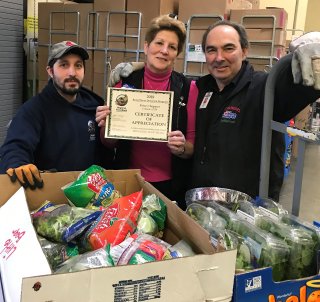
Preventing food waste through source reduction, which is at the top of EPA’s food recovery hierarchy, is a top priority for Price Chopper/Market 32, a regional supermarket chain based in Schenectady, New York.
In 2019, daily shrink (loss of product inventory) best practices and protocols resulted in nearly 16,000 tons of source reduction, while food banks and partner agencies collected 1,407 tons of fresh food. 4,484 tons of product not fit for human consumption were used for animal feed; 424 tons of fats, oil, and grease were collected for rendering or conversion; and 1,495 tons were composted. In total, the efforts of thousands of teammates helped Price Chopper/Market 32 divert over 30,000 tons of product from landfills.
As with any program of this scale, which involves employees’ efforts across 131 stores, 12 regional foodbanks, and countless retail partner agencies, there is an ebb and flow. Teammates come and go, as do partner agency volunteers, and mistakes happen. Price Chopper/Market 32 has found that consistent communication across all parties is the only way to ensure minimal disruption to the process.
“We recognize that the best way to minimize waste is to increase efficiency in production, inventory, and sales forecasting. As we improve these efforts, we also prioritize recovering viable fresh food to distribute to food banks that serve our hungry neighbors and following the food recovery hierarchy to prevent landfill waste.”—Patrick Iannotti, Director of Operations
Wegmans Food Markets
Rochester, New York

Every year, Wegmans Food Markets continues to expand its efforts aimed at minimizing all forms of waste in stores, with food waste front and center.
Following EPA’s Food Recovery Hierarchy, Wegmans first aims to minimize food waste at the source. This comes in the form of efficient ordering with the assistance of electronic sales data to keep inventory levels in line, as well as using less-than-perfect produce and slightly blemished food in culinary operations. All 106 Wegmans stores donate perishable and non-perishable food items to local food pantries and food banks each week, to get food into the hands of those who need it most. At 30 Wegmans stores, food scraps unsuitable for human consumption are sent to livestock farmers for animal feed, and all but one of their 106 store locations divert remaining food scraps for compost or anaerobic digestion.
Wegmans’ same-store food donations were up 1.65 million pounds in 2019 and up another 1.6 million pounds in 2020. Total company donations amounted to 18.6 million pounds in 2019 and 19.6 million pounds in 2020. Wegmans diverted 69.60 million pounds of food waste in 2019 and 69.67 million pounds in 2020.
“We’ve been addressing food waste since the 1970s, but over the last six years, we’ve focused on improving those efforts by increasing food donations. Food has a purpose—to feed people. We want to do everything we can to ensure the food in our stores serves that purpose to the fullest extent possible. By expanding our existing programs, educating our people, and helping them understand the programs, why they’re in place, their importance, and how they benefit the environment, community, and the company, we’ve experienced incredible success.”—Chris Foote, Wegmans Sustainability Manager
Ravitz Family Markets: Various Locations
New Jersey
Ravitz Family Markets continues to strive toward becoming a zero-waste facility. They have continued to grow their program over the years through meetings, training, and a commitment to working together with the community.
In partnering with The Food Bank of South Jersey, Ravitz Family Markets: Shoprite of Evesham Road donated over 50 tons of food to be distributed to those in need in the surrounding communities. Through the same partnership, the location at Shoprite of Union Mill Road donated over 53 tons of food, the Shoprite of Garden State Pavillion location donated over 142 tons of food, and the Shoprite of Mount Laurel location donated over 33 tons of food.
Ravitz Family Markets: Shoprite of Evesham Road was also able to divert over 70 tons of food waste in partnership with Organic Diversion LLC, which was recycled into animal feed for local farms. The Shoprite of Union Mill Rd. and Shoprite of Garden State Pavillion locations also both diverted over 70 tons of food, while the Shoprite of Mount Laurel location diverted over 37 tons of food to be recycled into animal feed. Ravitz Family Markets plan to continue growing their partnerships and food waste program.
"To Care Deeply About People, Helping Them To Eat Well And Be Happy." Ravitz Family Markets mission statement
Sodexo at Utica College
Utica, New York
Sodexo has prioritized food loss and waste reduction efforts as part of the company’s corporate social responsibility strategy for over 10 years. Ending hunger has been Sodexo’s philanthropic purpose since 1999, and the Sodexo Stop Hunger Foundation has provided over $35 million in grants to eradicate hunger in America.
One of Sodexo’s greatest lessons learned is that even if it educates people about the importance of mitigating food waste and increasing food recovery, the company must have the right resources in place to transport and refrigerate food. Working with organizations like Move for Hunger has demonstrated that having effective partnerships that span across the entire supply chain is critical to meet the company’s goals.
“If we have learned anything over the past 18 months, it should be that no one organization can accomplish mitigating food waste and ensuring surplus food gets to where it is needed most by itself. We need to think creatively across the entire supply chain and leverage the expertise and resources of both for-profit and nonprofit organizations. We must work together to save people and the planet.”—Roxanne Moore, Executive Director, Sodexo Stop Hunger Foundation
St. John’s University
Staten Island, New York
In 2019, St. John’s University’s sustainability efforts included recovering food to help alleviate hunger and source separating food waste for on-site aerated static pile composting. The university’s success is largely due to Chartwells Higher Education and student efforts through Academic Service Learning. St. John’s Academic Service Learning engaged faculty and student volunteers to donate quality, high protein prepared food to The Harding Ford Vision, Inc., a local New York City food pantry. In addition, Chartwells and St. John’s student workers, along with Director of Environmental and Energy Conservation, Thomas Goldsmith, composted food waste using an aerated static pile system from O2 Compost. In total, St. John’s University diverted 3 tons of food in 2019. For more information, watch this YouTube video: Full Service Organics: Organic Soil Composting at St. John’s University.
Sprouts Farmers Markets: Various Locations
New Jersey & California
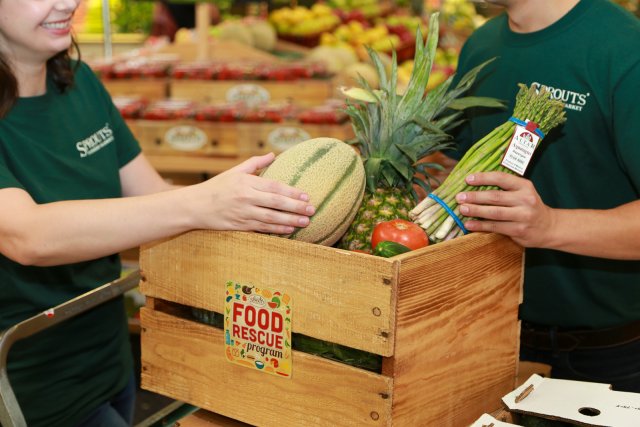
Sprouts Farmers Market has a robust Food Rescue Program where stores donate edible food, that is not in retail condition, to local food pantries and hunger relief agencies. Sprouts sends food that does not meet donation guidelines to local cattle farms or compost facilities. Sprouts uses meat rendering programs to process meat and seafood waste for more productive uses, and recycles the grease rendered from their roasted chicken program.
In 2019, Sprouts #945 diverted over 62 tons of food through the Food Rescue and Food Waste Recycling programs. As a company, Sprouts diverted over 22,000 tons through these programs.
2019 was Sprouts #945’s inaugural year; to accomplish recognition in such a short amount of time is a significant accomplishment in and of itself.
In 2019, various Sprouts Farmers Market locations achieved the following percent increases in food waste diverted:
- Sprouts Farmers Market #283 had an 8 percent increase in food waste diverted from 2018 (99 tons) to 2019 (107 tons).
- Sprouts Farmers Market #428 achieved a diversion rate of 52.38 percent.
“Working at Sprouts has given me a unique opportunity to interact with those serving some of the most vulnerable members of our local communities. Partnering with the Food Bank of South Jersey, we have volunteers pick up donations daily so we can get food directly to struggling families and their children, which is, in my opinion, one of the most impactful things you can do to directly serve your community. I’m proud to be able to take direct action to serve our local communities on behalf of Sprouts.”—Levi Young, Receiving Manager
HelloFresh
New York, New York
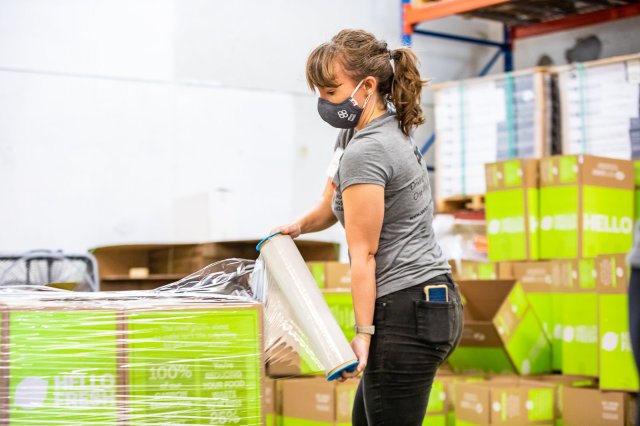
HelloFresh uses enhanced demand forecast modeling, smart just-in-time ordering, and robust rollover processes to reduce food surplus before it happens. While the company’s business model largely designs out significant operational food waste in comparison to traditional grocery retail, HelloFresh has taken the extra step to reduce the limited food waste it does produce.
In 2019, the total surplus accounted for only two percent of total purchased volume, 65 percent of which was donated to feeding people. This high donation rate can be attributed to long-term, strategic partnerships with five main donation partners across all the distribution centers in Texas, California, Colorado, and New Jersey. In New Jersey alone, HelloFresh’s partners have informed them that donated food is delivered to over 198 food banks and community organizations.
Some of the main challenges in 2019 can be attributed to operational efficiency to ensure consistent quality for customers. One way the company reduced food waste onsite and for customers was via the use of in-house plastic film bagging for high-risk produce items such as zucchini, carrots, and cucumbers. While packaging produce items can appear counterintuitive to customers, HelloFresh has found that this initiative reduces customer quality complaints and extends the shelf life of high-risk ingredients from a few days to up to two weeks.
“Our mission at HelloFresh is not only to change the way people eat, forever, but to uplift our local communities. Our rotating recipe model not only provides exciting variety for our customers, it allows us to identify and donate surplus food long before it becomes inedible. We are committed to increasing access to nutritious produce and other food items by donating them directly to the communities where we operate.”—Jeff Yorzyk, Director of Sustainability for HelloFresh U.S.
Mid-Atlantic Region (Region 3)
Virginia Department of Corrections
Richmond, Virginia
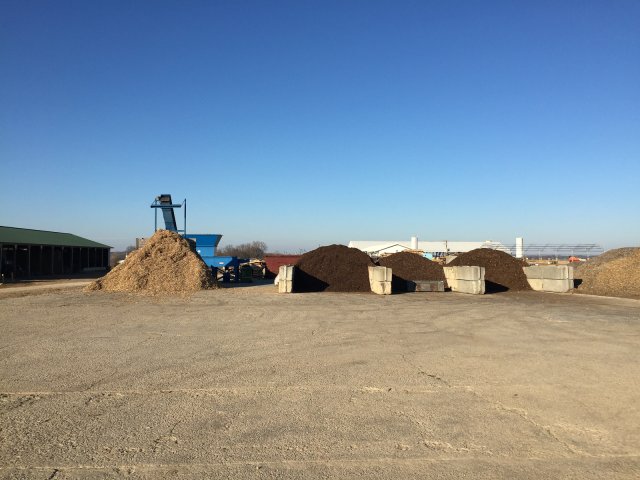
In 2019, the Virginia Department of Corrections (VADOC) had over 30,000 inmates in its 43 correctional facilities and employed 10,000 facility staff. Inmates and staff generated over 17,000 tons of trash for a cost of $1 million in landfill fees, as well as $200–$600 a month per site in dumpster rental fees. Waste audits have confirmed that approximately half of the waste generated by a correctional facility is compostable. A gap in the food loop was identified which, when closed, would lead to a cost-effective and environmentally friendly waste management solution for the VADOC.
VADOC had been operating a large-scale compost program in central Virginia for the past eight years and had successfully diverted a small amount of food waste from landfills. The availability of over 30 agribusiness farms allowed VADOC to expand their compost operation and use the compost on soils and gardens throughout the state.
Because of grant funds from the U.S. Department of Agriculture, the Agency developed and implemented twelve compost programs in 2019. Staff attended a week-long basic compost operations course. VADOC composted 892 tons of food waste in 2019, a 53 percent increase from 2018. During the first year, many sites were also able to reduce their tipping and dumpster rental fees by half. By closing the food loop, the Agency was able to save money and reduce the burden of waste on staff, operations, and the environment.
The greatest challenge in developing a large-scale compost operation was adapting to the unique logistical constraints at each location, such as managing security, transportation, inmate work schedules, and delivery and acquisition of bulking agents. Project leaders had to ensure there was an open flow of communication between all parties involved.
“We are excited to be composting at Green Rock. This program allows us to divert food waste from the local landfill, which reduces harmful greenhouse gases. This process also allows us to enrich the soil at Green Rock, improving our agribusiness production over time. There were initial concerns about composting having an unpleasant smell, but I am glad to report that this isn’t the case at all.”—Melvin Davis, Warden at Green Rock Correctional Facility
Great Lakes Region (Region 5)
FireKeepers Casino Hotel
Battle Creek, Michigan
FireKeepers Casino Hotel gives back to the community by supplying fresh produce to three local schools for healthy lunches, and through “The Fire Hub,” a fire station converted into a restaurant. The Fire Hub houses a food pantry, which works in conjunction with the South Michigan Food Bank to serve over 1,400 households. Through these efforts, FireKeepers increased its food donations by 271 percent in 2019.
“At FireKeepers, we are very concerned about being good stewards of the world we live in. We work to produce only the food we need. We save as much as possible through our blast chiller programs and distribute these nutritious foods rapidly to the local community. We are working on better ways to address our pre- and post-consumer waste by leveraging the latest advances in technology. Throughout our property, we have invested in solar power and electric vehicle charging stations, just two of the ways we can protect the environment with progressive action and reflect the priorities of our Tribal owners.” – Mike Hamilton, Vice President of Food and Beverage
Midwest Region (Region 7)
Iowa Waste Reduction Center - University of Northern Iowa
Cedar Falls, Iowa
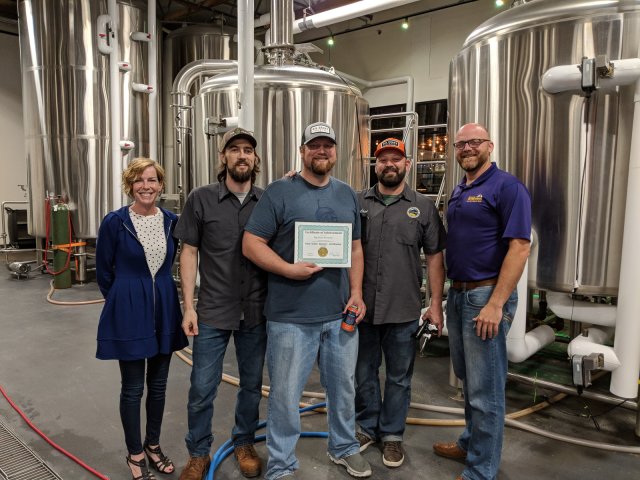
The Iowa Waste Reduction Center’s (IWRC’s) Food Waste Program provides on-site assistance to prevent and reduce food waste. Assistance includes training, educational campaigns, waste sorts, and implementing strategies from all levels of EPA’s Food Recovery Hierarchy. In 2019, clients included compost operators, breweries, K–12 schools, student organizations, colleges and universities, AmeriCorps, and food manufacturers.
The IWRC trained ten AmeriCorps members to conduct waste sorts and implement diversion strategies. The IWRC also provided training for 35 compost operators, conducted 14 food waste presentations that were educational and/or technical; some were an overview of EPA’s Food Recovery Hierarchy and issues associated with food waste and others included step-by-step instructions to implement replicable strategies. To prevent and reduce food waste, the IWRC provided technical assistance to 18 organizations and/or businesses including six breweries.
The IWRC was invited to the “Winning on Reducing Food Waste” event in Washington, DC, where the U.S. Food and Drug Administration, the U.S. Department of Agriculture, and EPA came together to improve interagency coordination to reduce food waste. By signing the pledge at this event, the IWRC promised to continue efforts that divert food waste from the landfill through sustainable methods.
The greatest challenge of 2019 was working with a K–12 school where four IWRC staff conducted waste sorts on three different dates, sorting a total of over 1,100 meals. After several meetings, the school district’s food service director decided against implementing any strategies or diversion tactics. However, the IWRC still asked K–12 schools to promise to implement at least one strategy recommended by the IWRC before waste sorts would commence.
“Our efforts to solve the food waste conundrum have always been holistic in that we use every strategy from EPA’s Food Recovery Hierarchy to meet the unique needs of each client."—Jenny Trent, Food Waste Program Manager
Shawnee Mission East High School
Prairie Village, Kansas
The Shawnee Mission School District cafeteria composting program began in 2008 and spread across the district as a grassroots effort led by students, parents, teachers, administrators, and community partners. The district’s food service department reduces waste at the source through efficiency and procurement. The school district eliminated Styrofoam in 2007. Reusable flatware and trays replaced disposables. On occasion, when disposable trays are used due to staffing shortages, compostable cardboard trays are offered. To reduce food waste, cafeteria staff used food logs to track how much of each menu item was consumed.
Staff use compostable cardboard boats to serve food. Water dispensers and paper cups replace plastic water bottles. Students are encouraged to “take what you want and eat what you take.” After lunch, kitchen staff compost the small amount of food that cannot be re-served.
In the cafeteria, color-coded bins, buckets, and signage provide visual cues to guide students and staff. The process was instituted districtwide as part of the 2015 strategic plan. By 2018, all schools and the Center for Academic Achievement administrative center were composting cafeteria food waste.
Shawnee Mission East was the first high school to take on cafeteria composting. Cafeteria composting in middle and high schools present significant challenges. 2018 data showed that Shawnee Mission East had experienced a significant decline in participation. With district and school administrative support, equipment was refurbished. The district provided updated receptacles with signage that have become the standard to help educate and build a common structure across elementary, middle, and high school students. The signage encourages proper disposal of recycling, food waste, and trash to students and staff. Johnson County Department of Health and Environment staff, parents, and administrators spent a week in the cafeteria, re-educating students about the why and how of the composting process. As a result, Shawnee Mission East students and staff composted 12.38 tons of food waste during 2019, a 538 percent increase from 1.94 tons composted the previous year. The composted food returns to school gardens and the culinary program’s urban farm to grow more food. The custodial staff, led by Mr. Dale Clark, and the Shawnee Mission East administrative team led the successful effort.
“We had an opportunity to build on the efforts of our elementary and middle schools in the area of food waste composting. Younger students were accustomed to managing food waste, so we were able to build on these efforts and expectations, which led to a significant increase in the positive impact our high school had on diverting and managing food waste.”—Dr. Scott Sherman, Director of Secondary Education and Former Principal
Kansas State University Pollution Prevention Institute
Manhattan, Kansas
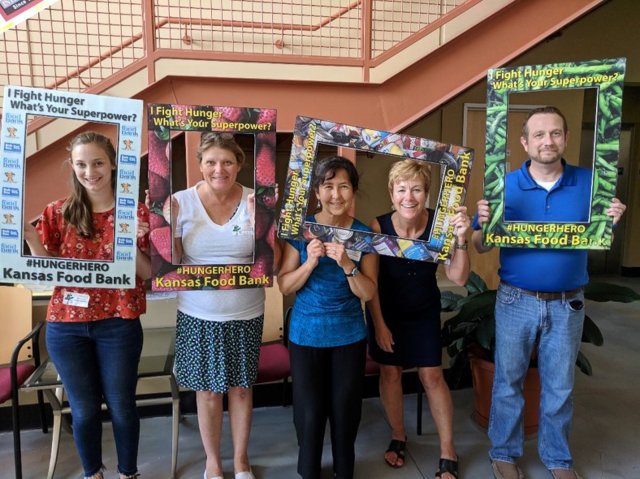
Kansas State University’s Pollution Prevention Institute’s (PPI’s) journey to providing food recovery technical assistance began in 2012, when a grocery store chain came to PPI seeking assistance with a dumpster leakage problem caused by food waste. Within a few months, PPI secured funding for a project titled “Food recovery challenge feeds Sedgwick County hungry.” Behavior change was, and in many cases still is, the single greatest challenge. Through top management support and employee retraining, the chain was able to implement food waste solutions. This grocer partnership was followed by other projects supported by small grants from state and local health departments, including work with local grocers, hospitals, food banks, school districts, and universities.
In 2019, PPI developed a standard operating procedure for the Lawrence Douglas County School Districts for safely donating excess food to local food banks. In 2019, PPI also developed a marketing campaign for Kansas State University student cafeterias that educated students about only taking food they will eat. The campaign included hard copy and digital messaging and was rolled out in the fall of 2019.
That same year, PPI worked with Wichita Building event hosts to facilitate donation of over 100 pounds of excess food to shelters and alcohol treatment programs to feed food insecure populations. As an endorser, PPI worked with and presented to various regional and state entities such as extension, local solid waste districts, grocery stores, and the Kansas Food Bank. PPI’s experience and success implementing food recovery initiatives emphasizing source reduction resulted in entities requesting PPI as presenters, exhibitors, or advisors for various projects. Between trainings, technical assistance, presentations, and outreach at day-long events, PPI has impacted more than 300 entities. Emphasizing the social, economic, and environmental impacts of food waste, PPI uses published case studies to help partners understand and replicate source reduction opportunities.
“The PPI’s team is passionate about providing food recovery assistance and awareness programing that results in social, economic, and environmental impact.”—Nancy Larson, Director, Pollution Prevention Institute
Pacific Southwest Region (Region 9)
Disneyland Resort
Anaheim, California
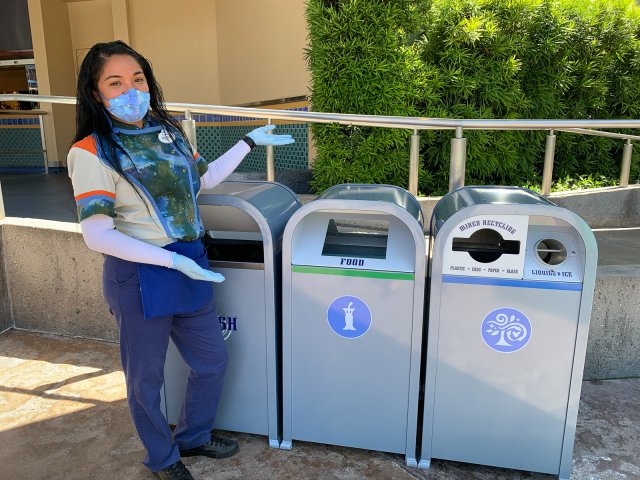
As a beloved tourist destination, Disneyland Resort serves guests from all over the world. One of many favorite guest offerings is food, which inevitably leads to some uneaten food. Disneyland Resort takes pride in delivering great culinary experiences while honoring its long-standing commitment to environmental sustainability. As part of that commitment, Disneyland Resort is working towards a goal of zero waste, with an emphasis on minimizing food waste within its operations.
Over the past decade, Disneyland Resort implemented numerous programs to reduce its environmental footprint. The programs specifically aimed at reducing food waste target each step of the food preparation and serving process. In 2019, those efforts led to over 8 million pounds of food diverted from landfills. Much of it was in the form of scraps from food preparation and guest leftovers, which was converted into animal feed amendment. Prepared, unused food eligible for human consumption is donated through the Second Harvest Food Bank of Orange County. Used cooking oil is collected for conversion into biodiesel and used to fuel the Disneyland Railroad steam trains and the Mark Twain Riverboat attraction. The biodiesel process eliminates the need for approximately 200,000 gallons of petroleum diesel per year.
“Taking action to manage food responsibly and reduce waste across our two theme parks and three hotels involves the planning and commitment of many people. Our culinary teams set the tone and enable much of this work to occur behind the scenes, finding creative ways to reduce food waste before it occurs. We know that wasted food has an outsized global impact and it’s something we know how to solve. Not everyone makes decisions about pollution-reducing technological breakthroughs, but everyone has an opportunity to reduce food waste and lessen the resulting impacts on the environment. At Disneyland Resort, we strive to do a lot of things well, including our ambition to become a zero-waste resort. As we continue on that journey and double down on our sustainability efforts, we hope to serve as an inspiration and invite others to take action with us.” —Jake Raykhelson, Environmental Initiatives
Zero Waste Company
Santa Monica, California
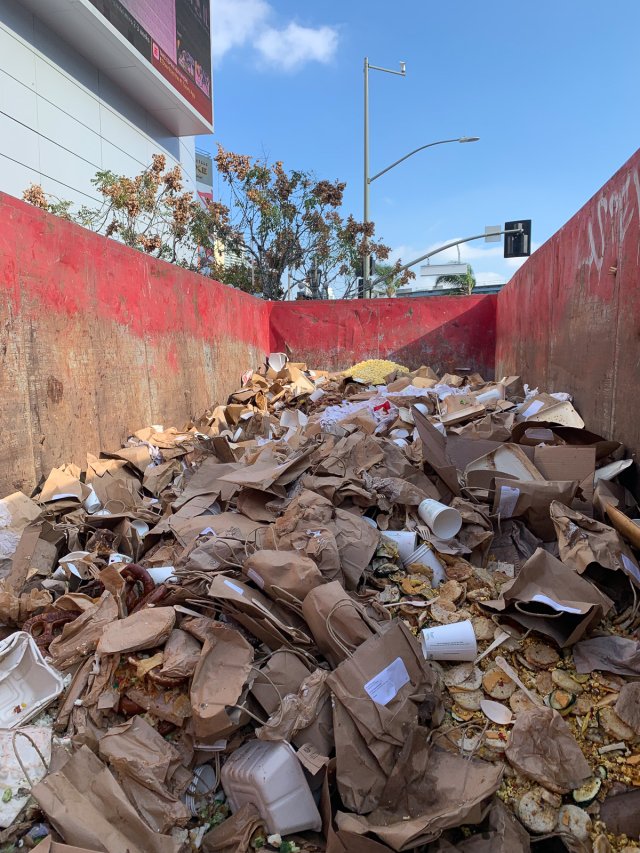
Zero Waste Company’s goal is to change the culture of special events production by demanding that social and environmental responsibility be at the forefront. In 2019, Zero Waste Company worked an event for 6,000 people who were served breakfast and lunch during a two-day event, totaling 24,000 meals in 48 hours. Zero Waste Company was hired to divert as much recycling and compost from the landfill as possible and analyze the event’s environmental impact for marketing purposes and future assessments. The company documented all outgoing donations and provided a detailed waste diversion report for the client. “If it can be measured, it can be managed” is Zero Waste Company’s mantra—equipping clients with data might help them make more informed choices when planning future events.
Zero Waste Company found that 4,800 out of 24,000 meals prepared were not eaten. Zero Waste Company coordinated the pickup and drop-off of food donations with several local charities. For that event, Zero Waste Company composted 4.07 tons of food waste.
Many of Zero Waste Company’s clients have modified their operations. Some have changed their policies at the highest level by not reimbursing meat-based meals. Another client has committed to only offering plant-based meals at all corporate functions. Zero Waste Company has also facilitated ongoing recycling and organics collection at several venues. By committing to these goals, companies are demonstrating to their interested parties that they are serious about addressing climate change.
Zero Waste Company provided resource recovery services for a conference at a very large venue in Los Angeles, California, where the food service provider was hesitant to allow food donations because of legal concerns. Zero Waste Company provided them information about the Good Samaritan Act, and they discussed liability issues regarding food donations with an LA County Health Department representative. Because of this research, the venue changed their vendor guidelines to promote food donation to local charities.
“My goal is to always leave a place better than when I found it, and it makes me happy that I get to teach people how easy and rewarding it can be to do the right thing. We need systems to change now, and we need to collaborate across industries to share best practices and employ all the tools we have at our disposal to protect the valuable resources on this planet for future generations. We look forward to shifting the paradigm of waste and creating more regenerative systems.”—Sofia Ratcovich, Founder of Zero Waste Company
San Diego County Regional Airport Authority
San Diego, California
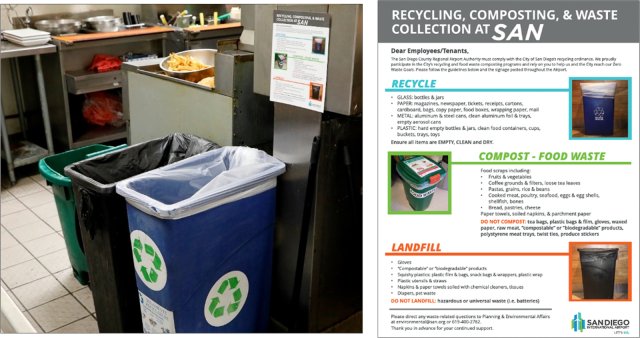
San Diego International Airport (SAN), which is operated by the San Diego County Regional Airport Authority (Airport Authority), serves about 25 million passengers each year. The Airport Authority instituted one of the first sustainability policies for a major airport in the U.S., formalizing the commitment to an environmentally sustainable future for the airport and the region. Recently, the Airport Authority created the Sustainability Management Program as the framework for advancing and measuring environmental sustainability progress. The program is comprised of seven individual plans, including water stewardship, strategic energy, carbon neutrality, clean transportation, zero waste, climate resilience, and biodiversity. The Airport Authority sets goals and standalone strategies in each programmatic area to achieve by 2035.
Environmental stewardship is a hallmark of all operations at SAN. The Airport Authority provides information about the recycling programs to employees and tenants, which is reiterated during trainings and public communications throughout the year. In 2019, SAN concessions collected and composted all their pre-consumer food scraps, and over 450 tons of food scraps were diverted to the Miramar Greenery Composting Facility. During the annual recycle check-in and bin audit in 2019, the Planning and Environmental Affairs Department distributed the City of San Diego’s recycling ordinance to all tenants and authority spaces and ensured that the bin signage was properly displayed.
In 2019, SAN recovered approximately 161,664 pounds of edible food, a 58 percent increase from 2018. Based on the U.S. Department of Agriculture’s estimate that the average meal weighs 1.2 pounds, SAN donated around 134,000 meals to feed the community through the San Diego Rescue Mission and the United Service Organization Neil Ash Airport Center.
Among the initiatives to promote sustainable concessionaires, in 2019 SAN introduced the Surfrider Foundation's Ocean Friendly Restaurant (OFR) certification program. SAN is the first Airport in the world to have a restaurant certified as OFR. It certifies concessionaires which have taken action to reduce plastics in our oceans, by eliminating plastic straws, reducing plastic packaging, and implementing reusable food ware for on-site dining. Concessionaires that achieve certification through the Surfrider program also get a decal which they can display to educate passengers on the program and raise awareness of their efforts. Einstein Bros. Bagels in Terminal 2 West became the first OFR certified restaurant in 2019. The Prado in Terminal 2 East also made changes to their operations to become OFR certified that same year. Education and engagement are key to reducing waste and increasing waste diversion.
“We aim to divert 90 percent or more of our waste away from landfills, whether we’re talking about food waste, donating food, or composting it. Every year we do a waste characterization study where we sort through the bins and look at what’s going into our recycling and trash bins, so we can find opportunities to reduce waste further. Handling food waste is certainly a team effort, and teamwork is foundational to having a successful airport program. The food waste program has created an opportunity to engage concessions at the employee level. They understand what can be put in a food waste bin, how we process scraps with our logistics provider, and how we handle edible food donations. The biggest lesson learned is that it really takes collaboration.”—Brendan Reed, Director of Airport Planning and Environmental Affairs
Windward Zero Waste School Hui
Kailua, Hawaii
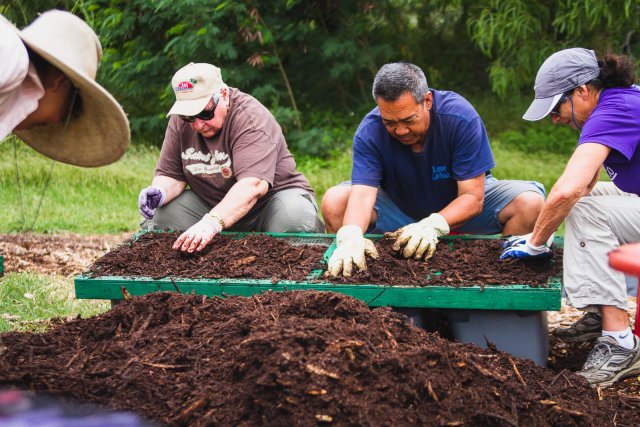
The Windward Zero Waste School Hui (WZWSH) is a project of the Oʻahu Resource Conservation and Development Council. Public and private grants support a staff of seven certified resource recovery specialists who collect and process 100 percent of the food waste generated across five campuses. All other organics—paper, cardboard, and green waste—are also processed on site. The WZWSH services one intermediate school and four elementary schools with a total student enrollment of 2,600.
Every student participates in daily food waste recovery activities, including age-appropriate aspects of hot composting and vermicomposting, such as collecting and logging data, preparing worm bin bedding, and harvesting and screening finished compost and vermicast for school use and for sale to the community.
In 2019, WZWSH established a significant online presence to manage the Compost Club and product sales, and to promote the philosophies and practices that transform damaged and depleted sites into rich, balanced, sustainable ecosystems.
With operations at full capacity at five schools, WZWSH recovered a record 55.2 tons of food waste in 2019, exceeding 43.8 tons recovered in 2018. Staff harvested 53 cubic yards of finished compost and 1,475 pounds of vermicast. Sales of surplus compost and vermicast totaled $17,305. The total 2019 revenue from recovered resource products was $26,085.
The Windward Zero Waste School Hui overcame a formidable challenge in 2019. The Hawai‘i Department of Education (HIDOE) subscribes exclusively to the dumpster/incinerator model of waste management and does not support waste diversion or recycling in public schools. The state legislature appropriated $300,000 to finance staffing and expanding established Zero Waste schools, but HIDOE diverted the money to conduct a study instead. This unexpectedly left WZWSH with no funding to cover payroll in 2019. WZWSH staff pushed on through a year of serious financial stress to hit record numbers in all deliverables, including waste processed, training goals, products sold, and student and community interaction and involvement.
“At Kaʻelepulu Elementary School, we value our community partnership with the Windward Zero Waste School Hui, as it supports our mission of helping our students become lifelong learners and contributing citizens. Our students learn how to sort and manage their food waste as early as kindergarten. Through everyday practice, students learn how to be future stewards of our island community and support community resilience by turning waste into compost and vermicast to nourish our school and home gardens.”—Dr. Cherilyn M. Inouye, Principal of Ka‘elepulu Elementary School
